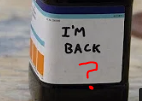
nimgoldman - 1-9-2019 at 22:05
I have an old bottle labeled "Cu waste". It contains dissolved copper from my early experiments, namely making basic copper carbonate, reaction
mixture from pyridine synthesis (using basic Cu carbonate as catalyst) and from dissolving Cu in nitric acid.
The solution is acidic so I neutralized it with sodium carbonate and believed the copper would precipitate as carbonate. This did not happeded.
I added some conc. hydrogen peroxide (in a test tube) which caused brown precipitate but for the whole bottle (about 1L of solution) I had to use over
250 mL of 30% H2O2 without having significant precipitation (the heavy metal test paper still showed high concentration of Cu[2+] ions.
Now I am lost. I don't want to use more H2O2 because it's precious for me, but the copper refuses to precipitate. Every addition causes fizzing and
little more brown precipitate, but not much.
I plan to reduce the liquid or maybe evaporate, but I am of course worried about the contained peroxide (hopefully it is reacted by now).
I admit it was stupid to mix all my Cu waste like that, it is a "skeleton in the closet" from my amateur chemistry beginnings and I'd like to deal
with it finally...
How would you process your copper waste provided you don't have hydrogen peroxide?
Herr Haber - 2-9-2019 at 03:59
It depends what the goal is.
If you just want copper toss some zinc in.
unionised - 2-9-2019 at 12:15
Add (steel) wire wool to the copper solution.
The iron will displace copper and you can filter that off.
There will probably be some iron oxide/ hydroxide produced, so it won't be very pure but ...
Some of the iron will go into solution, but iron isn't very toxic to the environment so you can dispose of that solution down the drain (preferably in
rainy weather).
If you slightly acidify the solution before you add the wool you will get cleaner copper, but it might be a waste of acid.
(still, easier to get acid than peroxide)
nimgoldman - 9-9-2019 at 17:29
The goal is just to reduce the amount of waste and make the liquid safe enough to be poured down the drain.
Okay I will acidify the mixture and perform the displacement with iron. Hopefully a steel wool (the one for cleaning dishes) will do the job.
I have zinc powder but I am afraid zinc is one of the less eco friendly heavy metals compared to iron.
I found some cheap 10% H2O2 so maybe I will also continue along this route.
Sulaiman - 10-9-2019 at 01:11
Small note regarding kitchen scouring pads;
there is steel wool, usually quite fine strands and rusts easily,
consisting mostly of iron and carbon,
and there is stainless steel wool that does not easily rust
and contains chromium and often other heavy metals.
Praxichys - 11-9-2019 at 06:13
Add sodium bicarbonate until it's basic (watch out for foaming), then mix the whole thing, precipitated sludge and all, with Quikcrete or some other
inexpensive concrete bag mix. Cast it into something disposable, let it harden, then pitch it into the landfill.
I find this method far less tedious and costly than actual recovery, as long as I don't care about having the metals back. A 94-pound bag of cement
where I live is about $8.
Further, there are copper products out there like ZEP Root Kill that are literally just commercial grade copper sulfate and designed to be poured
directly down drains to kill roots. Sure, we should all do our part, but I wouldn't worry too much about releasing small amounts of copper waste down
the sink when consumer products far outpace amateur chemistry in terms of environmental impact.
For things like Hg and As, I keep all solutions and wash water for processing. Cu and Zn solutions get the concrete treatment, but I just rinse the
apparatus in the sink.
OldNubbins - 11-9-2019 at 06:27
I second this - also have used leftover plaster, epoxy, grout, anything that cures/hardens.

MrHomeScientist - 11-9-2019 at 10:15
I think the steel wool method is the best of the suggestions. Quick, cheap, and easy.
I have some Cu waste that I neutralized with baking soda, hoping to precipitate all the copper. I found that when pH is neutral, the solution is still
blue with some dissolved Cu. Pushing it alkaline with more baking soda even seems to re-dissolve some of the precipitate. I'll try treatment with
steel wool and I expect that will finish it off.
